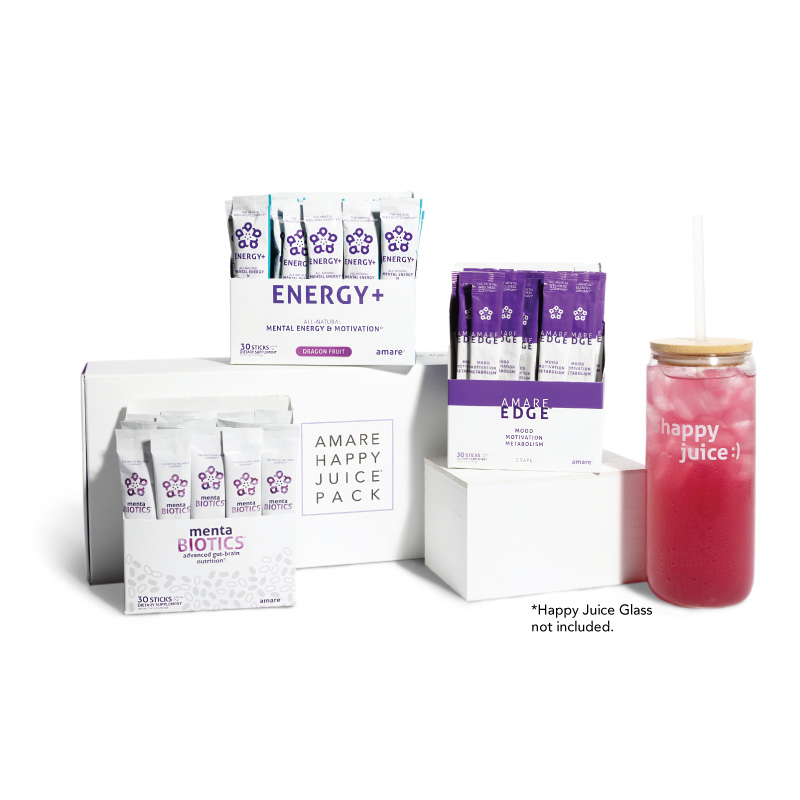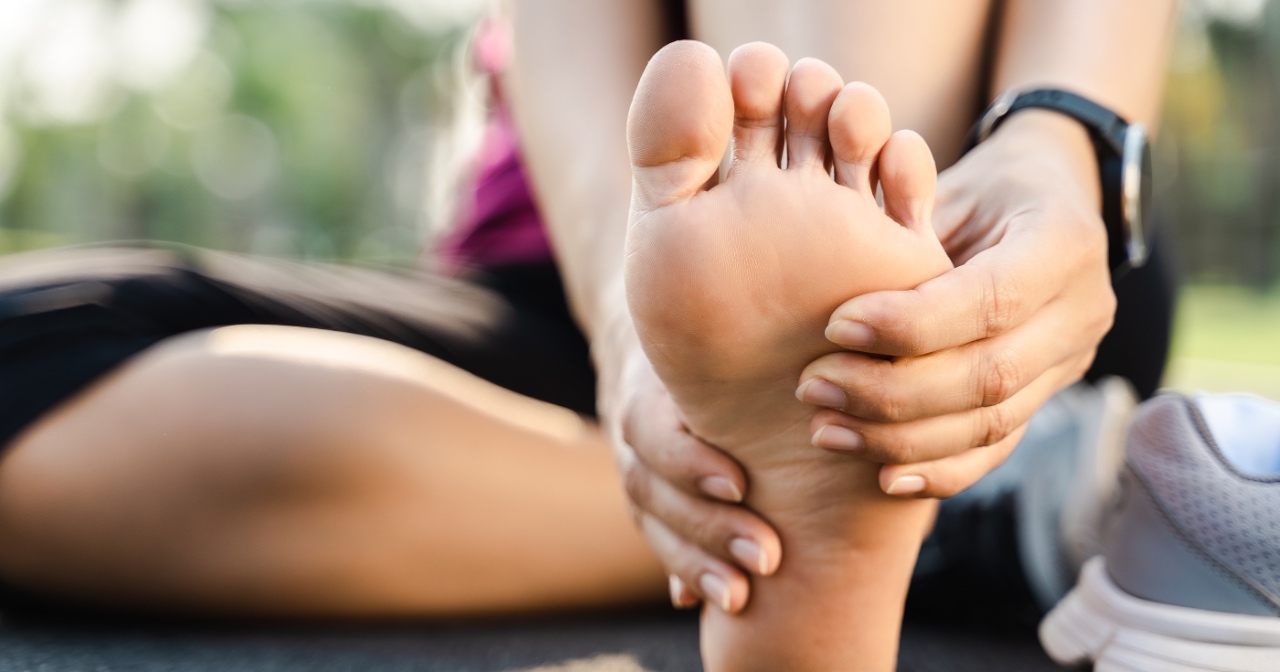Listen on: Apple Podcasts | Spotify
Some people deal with muscle cramps (Charley horses) on occasion, and others experience cramping multiple times each week.
While they aren’t harmful, they can be pretty painful. And while the exact cause of cramping isn’t known, you may be able to reduce the likelihood of getting them.
In this article, I’ll address the following concerns:

Feel Better Fast. Guaranteed.
Energy+, EDGE, and MentaBiotics make up the Happy Juice supplement stack, with ingredients clinically proven to:
- decrease anxiousness scores by 55%
- decrease irritability scores by 60%
- decrease fatigue by 64%
- decrease anger 54%
- decrease tension by 45%
- decrease confusion by 43%
- decrease overall distress by 49%
- increase good bacteria by 70%
- decrease negative mood by 105%
- increase positive mood by 211%
What is a muscle cramp (Charley horse)?
A muscle cramp is a “painful, spasmodic, involuntary contractions of skeletal muscle during or immediately after physical exercise” (Schwellung MP et al.).
A cramp isn’t the same as a muscle spasm. Spasms rarely cause pain and cause light, repeated contractions as opposed to a constant and significant contraction.
A Charley horse is a muscle cramp in the leg. The slang term stems from baseball as far back as the late 1800s.
Muscle cramps usually fall into two categories:
- Exercise-associated muscle cramps (EAMC): Cramps that occur during or immediately after exercise in the muscles used during training or prolonged physical labor or activity.
- Rest cramps or nocturnal cramps: Cramps that occur at night, most often in the thighs, calf muscles, or feet.
Pregnant women and older people are more likely to experience rest or nocturnal cramps. They are not the same as restless leg syndrome.
What causes muscle cramps?
We often assume scientists know everything about the human body. Yet, there’s a lot we don’t yet fully understand. The cause of muscle cramps is one such issue.
Exercise physiologists and scientists fall into two camps when it comes to the cause of muscle cramps. They believe cramps are caused by:
- Dehydration or electrolyte imbalance
- Nervous system excitation
Though most people have been sold the idea that cramping is about hydration and electrolytes, the evidence shows that’s probably not the primary cause.
Electrolyte imbalance and dehydration
High-quality research dating back to the 1920s and 1930s showed that physical labor performed under high heat caused cramping. Miners, ship’s stokers, and construction and steel mill workers were prone to muscle cramps.
Researchers observed that drinking plain water made the cramping worse.
Back then, they could measure blood levels of chloride, but not sodium, and noticed that low chloride levels were associated with higher rates of cramping. Today, we know that chloride and sodium levels go hand in hand, and sodium is the more significant concern.
In reality, sodium, potassium, magnesium, and calcium all play essential roles in muscle contraction and relaxation, which is why most electrolyte replacements contain all of these micronutrients.
Soccer, American football, and basketball players often cramp as well. Some research shows that football players who sweat out higher concentrations of sodium are more likely to cramp.
When it comes to the electrolyte hypothesis, one thing is clear: Drinking plain water does not reduce the occurrence of cramps. It increases it.
When you drink only plain water while excreting significant amounts of sodium (salt) through sweat, you dilute your body’s sodium concentration.
In a controlled environment, severe restriction of dietary sodium intake can result in hyponatraemia and may be associated with generalised skeletal muscle cramping in the absence of exercise.
Maughan RJ, et al.
Consider that statement in light of today’s salt-demonizing dietary recommendations.
If you severely cut back on salt intake or drink an excess of plain water, you can cause hyponatremia. Older adults often have pre-existing medical conditions or take medications that may disrupt their electrolyte balances. Following a low salt diet may lead to ongoing problems with cramping.
As an example, the use of low-sodium dialysis fluids in renal patients may trigger muscle cramps.
Though some research shows consuming electrolytes during intense physical activity reduces the occurrence of EAMC, other research shows electrolytes do not impact cramping.
This led researchers to look into a different mechanism for muscle cramps.
Altered neuromuscular control
Morse code operators in the early 1900s often experienced cramping in their hands. As you might expect, these workers weren’t dehydrated, so an electrolyte imbalance couldn’t be the issue.
During the 1980s and 1990s, researchers studied athletes and found that sweating wasn’t always associated with cramping.
Without getting overly technical, they observed that extreme muscle fatigue often led to cramping after exercise. It’s as though the muscle fatigue altered neuromuscular control, and the nervous system caused prolonged muscle contraction.
Chiropractors may attest to this as well.
It’s not uncommon for people with muscular imbalances to experience cramps, even if they don’t exercise. For example, lordosis is an excessive curve in the spine. The exaggerated curve alters the length of muscles in front of and behind the spine. The low back muscles can get excessively tight, causing chronic, low-level muscle contraction, which leads to cramping.
Physical fitness doesn’t necessarily prevent cramps. Physically fit people may have more stamina than those out of shape, helping them endure more physical labor, leading to an increased rate of cramps.
I’ve experienced excruciating cramps in my adductors and medial hamstrings from spending days cutting and chipping trees. The repeated bending and leaning in the same position for hours, combined with my poor choice to drink only plain water while I worked in the heat, left me howling in the evenings after work.
Though the two hypotheses exist, more than likely, electrolyte imbalance and altered neuromuscular control both contribute to cramps. In some people, one or the other may be the primary cause. In others, both could contribute. Preventing or alleviating muscle cramps requires addressing both potential causes.
Who is most likely to get cramps?
Intense exercisers and manual laborers
In sports, cyclists, triathletes, and marathon runners are the most likely athletes to experience exercise-associated muscle cramps. The repetitive nature of endurance exercise causes isolated muscle fatigue, and these athletes often sweat profusely.
However, EAMCs are common in American football, soccer, and basketball players, too.
Though the term “exercise-associated muscle cramps” suggests they are unique only to intense exercise, this is the same type of cramp manual labor causes.
Older adults
As adults age, they become more susceptible to both types of cramps.
According to one study (Naylor et al.), one-third of adults over the age of 50 experienced cramps in the past two months, and of that group, 40% dealt with cramps three or more times per week.
Older people are also more likely to have one of the diseases or take one of the medications mentioned below.
Women during pregnancy
Pregnancy weight gain adds strain on the muscles of the low back and lower body. Women who spend significant time on their feet later in their pregnancies may experience rest or nocturnal cramps.
While the cramps may be painful, being physically active during pregnancy plays a crucial role in the health of a developing baby.
Low-carb or ketogenic dieters
Low-carbohydrate or ketogenic diets cause significant sodium loss.
It’s one reason low-carb dieters need to salt their water or make some broth with a bouillon cube.
While I’m a huge advocate of low-carb diets for those with insulin resistance, diabetes, metabolic syndrome, or non-alcoholic fatty liver disease, I strongly recommend drinking plenty of water with added salt when following such a diet.
Patients with certain diseases or taking specific medications
Medications and certain diseases can cause rest or nocturnal cramps, including:
- Amyotrophic lateral sclerosis/motor neuron disease
- Recovered poliomyelitis
- Nerve root compression
- Polyneuropathies
- Liver failure
- Diuretics
- Inhaled beta-agonists
- Haemodialysis
If you have any such diseases or take the medications above, check with your doctor before trying any cramp-reducing supplements or therapies. The therapy may interfere with your treatment.
How to avoid or get rid of muscle cramps
The following are the most common recommendations to prevent muscle cramps or relieve them once you get them. However, research does not necessarily support each of these recommendations. I included a couple of them only to show that the recommendations don’t have scientific evidence.
Static stretching
When you ask health and fitness professionals or sports medicine doctors how to reduce or relieve cramps, they’ll often recommend static stretching. Limited and early research suggested that regular stretching reduced the likelihood of EAMC.
However, multiple, higher-quality studies show that static stretching has little to no effect on reducing them.
Static stretching before exercise may compromise strength and power, though it may not negatively impact performance before endurance sports.
That said, if you’re able to gently stretch a muscle while it’s cramping, it might be worth trying.
Magnesium
Magnesium plays a role in more than 600 enzymatic reactions throughout the body, including muscle contraction and relaxation.
While it does reduce the occurrence of restless leg syndrome, a Cochrane Library review shows that magnesium supplementation doesn’t significantly reduce muscle cramps.
Pickle juice
Pickle juice has a high salt concentration, which is why it’s been traditionally recommended for reducing cramps.
One study showed that 1 mL of pickle juice consumption within two seconds of cramping onset reduced cramping by 37%.
The pickle juice did not impact electrolyte levels, though. This led the researchers to believe pickle juice reduced cramping by stopping the motor neurons from triggering muscle contraction in the affected muscles.
The taste of the pickle juice may play a role in its effectiveness, so it isn’t only about the salt.
Quinine
Quinine, an old anti-malarial drug, reduces the frequency and intensity of leg cramps. Doctors typically prescribe doses of 200 to 500 mg as an off-label nocturnal leg cramp treatment.
Quinine can cause side effects such as cardiac arrhythmias, thrombocytopenia, and hypersensitivity reactions, so your doctor probably wouldn’t recommend it as the first treatment option.
You can also get quinine by drinking tonic water, which contains 60-70 mg per liter.
L-Carnitine
In a study of diabetic patients who experienced leg cramps, L-carnitine supplementation reduced leg cramps. Research shows l-carnitine also reduces cramps in patients with cirrhosis, on dialysis, and those taking Vismodegib.
As an amino acid, it’s unclear why this would happen. Fortunately, L-carnitine is safe and offers numerous other health benefits, so it may be worth trying, especially for those who suffer from nocturnal muscle cramps.
HotShot – Capsaicin, Ginger, and Cinnamon
HotShot is a patented supplement formula designed specifically to target the misfiring of nerves during a cramp, not the potential electrolyte imbalance.
Even though it wasn’t designed for muscle soreness, research shows it also reduces delayed onset muscle soreness.
The inventor named it “HotShot” for good reason. It’s hot. Capsaicin, ginger, and cinnamon are extremely spicy.
When consumed, the spices tigger nerves in the mouth and esophagus. They send a calming signal to the nerves in the spine, where they “inhibit the repetitive firing of hyperactive nerves in your muscles,” stopping muscle cramps and reducing muscle soreness.
Rather than using it as a daily supplement, you take it before activity that’s likely to cause cramps.
While I have no vested interest in recommending it, the science is sound. If you experience regular exercise or physical labor-induced muscle cramps, it’s worth a shot to try it (pun intended).
Summary
Though they can be extremely painful, muscle cramps are not life-threatening. If you’re an athlete, consider using a high-quality electrolyte solution before and during prolonged exercise. The same goes for those who perform intense manual labor, especially if it involves repetitive movements.
To cover both possible causes of cramps, you might also consider using HotShot on occasion. Again, I have no affiliation with the company, but I find the research support to be compelling.
For those with nocturnal or rest cramps, L-carnitine is safe and seems to be pretty effective.
With all that said, you might do everything right and still wake up to a painful Charley horse on occasion. They say that “pain is weakness leaving the body,” so maybe you’ll end up shedding a bunch of weakness after it’s all over.
References
Craighead, Daniel H., et al. “Ingestion of TRP Channel Agonists Attenuates Exercise-Induced Muscle Cramps.” Muscle & Nerve, vol. 56, no. 3, Sept. 2017, pp. 379–85. PubMed Central, doi:10.1002/mus.25611.
Dinehart, Matthew S., et al. “L-Carnitine Reduces Muscle Cramps in Patients Taking Vismodegib.” SKIN The Journal of Cutaneous Medicine, vol. 2, no. 2, 2, Mar. 2018, pp. 90–95. www.jofskin.org, doi:10.25251/skin.2.2.1.
Electrolyte and Plasma Changes after Ingestion of Pickle Juice, Water, and a Common Carbohydrate-Electrolyte Solution – PubMed. https://pubmed.ncbi.nlm.nih.gov/19771282/. Accessed 27 Apr. 2021.
Garrison, Scott R., et al. “Magnesium for Skeletal Muscle Cramps.” The Cochrane Database of Systematic Reviews, vol. 2012, no. 9, Sept. 2012. PubMed Central, doi:10.1002/14651858.CD009402.pub2. “
HOTSHOT | Big Science In A Small Package.” Teamhotshot.Com, https://teamhotshot.com/science/. Accessed 27 Apr. 2021.
Imbe, Ayumi, et al. “Effects of L-Carnitine Supplementation on the Quality of Life in Diabetic Patients with Muscle Cramps.” Endocrine Journal, vol. 65, no. 5, 2018, pp. 521–26. J-Stage, doi:10.1507/endocrj.EJ17-0431.
Maughan, Ronald J., and Susan M. Shirreffs. “Muscle Cramping During Exercise: Causes, Solutions, and Questions Remaining.” Sports Medicine (Auckland, N.z.), vol. 49, no. Suppl 2, 2019, pp. 115–24. PubMed Central, doi:10.1007/s40279-019-01162-1.
Miller, Kevin C., et al. “Reflex Inhibition of Electrically Induced Muscle Cramps in Hypohydrated Humans.” Medicine and Science in Sports and Exercise, vol. 42, no. 5, May 2010, pp. 953–61. PubMed, doi:10.1249/MSS.0b013e3181c0647e.
MUSCLE CRAMPS DURING MAINTENANCE HÆMODIALYSIS – The Lancet. https://www.thelancet.com/journals/lancet/article/PIIS0140-6736(72)91224-X/fulltext. Accessed 26 Apr. 2021.
Nakanishi, Hiroyuki, et al. “L-Carnitine Reduces Muscle Cramps in Patients With Cirrhosis.” Clinical Gastroenterology and Hepatology: The Official Clinical Practice Journal of the American Gastroenterological Association, vol. 13, no. 8, Aug. 2015, pp. 1540–43. PubMed, doi:10.1016/j.cgh.2014.12.005.
Naylor, J. R., and J. B. Young. “A General Population Survey of Rest Cramps.” Age and Ageing, vol. 23, no. 5, Sept. 1994, pp. 418–20. PubMed, doi:10.1093/ageing/23.5.418.
Russell, Brent S. “The Effect of High-Heeled Shoes on Lumbar Lordosis: A Narrative Review and Discussion of the Disconnect between Internet Content and Peer-Reviewed Literature.” Journal of Chiropractic Medicine, vol. 9, no. 4, Dec. 2010, pp. 166–73. PubMed Central, doi:10.1016/j.jcm.2010.07.003.
Saguil, Aaron, and Rebecca Lauters. “Quinine for Leg Cramps.” American Family Physician, vol. 93, no. 3, Feb. 2016, pp. 177–78. Schwellnus, M. P., et al. “Aetiology of Skeletal Muscle ‘cramps’ during Exercise: A Novel Hypothesis.” Journal of Sports Sciences, vol. 15, no. 3, June 1997, pp. 277–85. PubMed, doi:10.1080/026404197367281.
Schwellnus, Martin P. “Muscle Cramping in the Marathon : Aetiology and Risk Factors.” Sports Medicine (Auckland, N.Z.), vol. 37, no. 4–5, 2007, pp. 364–67. PubMed, doi:10.2165/00007256-200737040-00023.
“Underlying Chronic Disease, Medication Use, History of Running Injuries and Being a More Experienced Runner Are Independent Factors Associated With Exercise-Associated Muscle Cramping: A Cross-Sectional Study in 15778 Distance Runners.” Clinical Journal of Sport Medicine: Official Journal of the Canadian Academy of Sport Medicine, vol. 28, no. 3, May 2018, pp. 289–98. PubMed, doi:10.1097/JSM.0000000000000456.
Sweat and Sodium Losses in NCAA Football Players: A Precursor to Heat Cramps? – PubMed. https://pubmed.ncbi.nlm.nih.gov/16521848/. Accessed 26 Apr. 2021. Young, Gavin. “Leg Cramps.” BMJ Clinical Evidence, vol. 2015, May 2015. PubMed Central, https://www.ncbi.nlm.nih.gov/pmc/articles/PMC4429847/.



